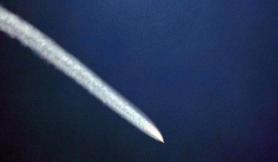
[Courtesy of Aircraft Spots]
U.S. planes such as RC-135V/W Rivet Joints and RC-12Xs are invisible to public eyes, although they make regular flights on and outside the Korean peninsula to closely monitor North Korean troop movements.
RC-135 Rivet Joint's sensor suite allows monitors to detect, identify and geolocate signals throughout the electromagnetic spectrum. RC-12X is based on the U.S. Army's intelligence system which provides operational commanders with near real-time intelligence, precise geolocation data and persistent targeting information.
"USAF RC-135V 63-9792 TORA35 operating over the Korean Peninsula at 31,000 feet (9448.8 meters)," Aircraft Spots, an aircraft tracking site, said in its Twitter post on Friday. The trajectory marked on a map showed a plane making a turnaround flight near the west coast after flying parallel along the demilitarized zone, which splits the Korean peninsula. The flight path covered Seoul and its surrounding areas.
The site has tracked the surveillance mission of RC-135V/W, which also made similar flights in South Korea on May 13, 14 and 16. The frequency of flights drew particular attention as the test launch of what North Korea called "tactical guided weapons" on May 4 and 9 has become a prominent issue in South Korea.
Military and government officials in Seoul have been unusually cautious, refusing to characterize the type of new North Korean weapons, although some experts suggested that the North has tested a version of Russia's ground-to-ground ballistic missile, Iskander, which has a range of about 280 kilometers (174 miles) when carrying a warhead of up to 500 kilograms.
Iskander flies on a flattened trajectory, never exceeding an altitude of about 50 km, Michael Elleman, an expert at the International Institute for Strategic Studies (IISS), said, adding the missile can alter its flight path after the boost phase, and over its entire trajectory, with defenses unable to precisely predict its flight path.
"The official position of the South Korean and U.S. governments is that the two governments are closely analyzing the specifications of short-range projectiles launched by North Korea this time," Chung Eui-yong, who heads the presidential National Security Office, told reporters on Friday.
"Size does not matter," said Duyeon Kim, an adjunct senior fellow at the Center for a New American Security, and Melissa Hanham, an expert on weapons of mass destruction, in a joint article published by the Bulletin of the Atomic Scientists, a nonprofit organization concerning science and global security issues.
They warned that the smaller, solid-fuel missiles matter because they can be tipped with nuclear warheads or chemical or biological weapons. "Indeed these may be the first weapons used in a large scale conflict that could pull allies in."
"The lack of an international response only emboldens the regime to sharpen its gray-zone tactics to push the envelope and gain influence without having to explode nuclear devices or fire long-range missiles," the article said, urging the international community to do more in response to North Korea's seemingly lower-grade provocations.
"Pyongyang achieves political objectives while advancing its weaponry by testing short-range ballistic missiles by another name. The tests enable the regime to fight pressure with pressure without crossing red lines, to up the ante, and to dictate the terms of negotiations," the article said.
"These missiles warn that a more severe crisis could come if Washington does not cooperate on Pyongyang’s terms by the end of the year. They pressure South Korea to unambiguously stand by its Northern brethren during nuclear diplomacy with Washington, instead of attempting to play mediator, and they are handy tools to later hold South Koreans and Americans living in the South hostage."
Copyright ⓒ Aju Press All rights reserved.



